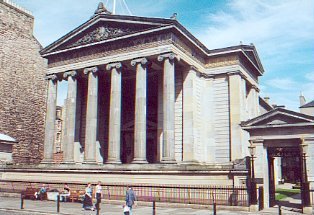Last Saturday, one of my flatmates and I decided to check out Mary King's Close: a series of underground streets that were populated by over 700 people during the 17th century. The tour was conducted by a 3rd-person costumed historian, which means our guide was in costume and had a 17th century identity, but spoke from the present day. (For example: "This is my house, which I share with 12 other people. This is very common, and...If you live here during the 17th century, it would have been..." I did this type of interpretation at Hartwell Tavern in Lincoln, and it's a great way to deal with large groups and foreign visitors.)
 |
| Disclaimer: Photos aren't allowed on tour, so these are from the company's website |
This picture is of another room in the close which was really interesting-but it didn't look exactly like this when we were there (there are more toys now). One of the areas we went into was an original 17th century house, with the original walls and ceiling, made out of a mixture of water, dirt, and human ash. The history dork in me was really excited about this! The story goes that in the 1990s a psychic from Japan came to visit the close, and when she entered one particular room in the house she was filled with the sensation of overwhelming sadness. In the corner of the room she saw a little girl, who told her that her name was Annie and that she had been left there by her family, who had died of the Plague. The reason she was sad was because she had lost her toy dog. So the psychic went up to the Royal Mile and purchased a tartan barbie in one of the tourist shops. When she placed it in the room, she said that the feeling of sadness disappeared.
Over the years people have left all sorts of toys and gifts for Annie in the room, and there's a big mountain of them now. That was really neat to see as well. In March the close hosts "Ghost Fest"-I may need to check it out.
Another museum I've been to recently was the Surgeon's Hall Museum, which was recommended by my history tutorial leader. I thought it sounded really interesting, and I walk past the building all the time so I was curious to see inside. What I didn't count on (which seems really stupid now) was that a museum about medical history would mean lots of preserved body parts. EW! Really not my thing-although nothing bothered my quite as much as the exhibit about facial deformities and tumers; the parasites; and the 18th century child's head in a jar...bonnet and all. YUCK.
 |
| Similarly, no pictures inside Surgeon's Hall. These are from tourism sites. |
In 11 months, the pair killed 17 people. Apparently, this is where the term "burking" comes from, and it means to purposely smother someone. When the men were arrested in fall of 1828, there wasn't enough evidence to convict. In exchange for immunity from prosecution, Hare confessed, leaving Burke to be tried alone. I think the final ruling was actually kind of perfect-Burke was condemned to death by hanging (which was very common for murderers at the time), and the to have his body publicly dissected (which is not). Poetic justice, don't you think?
Among the things in the Burke and Hare exhibit at the museum are a plaster cast of Burke's head (post-hanging; you can see the rope marks in his neck!), the skull of one of the victims they sold to Knox, and a wallet made out of Burke's skin (called a pocket-book or purse in the UK). On the front it says "Burke's Skin Pocket-Book" and on the back "Executed 28 Jan 1829."
The Burke and Hare murders have been inspiration for tons of fiction, including a short story by fellow Edinburgh resident Robert Louis Stevenson (The Body Snatchers), and several movies. In fact, there's a new Burke and Hare movie (it's supposed to be a dark comedy) coming out in the UK on October 29th, and it was filmed right here in Edinburgh!
Here's the trailer:
The other exhibit I really liked was called "The Real Sherlock Holmes." Arthur Conan Doyle was a medical student at Edinburgh, and apparently he based Holmes on one of his professors, Joseph Bell (in addition to a few other Edinburgh figures.)
Many of Bell's items are on display, as well as a map of the several buildings Doyle lived in. One of them, 23 George Square, is now on campus! I was very excited about that. There was also a section on the real Doctor Watson, who was an Edinburgh figure as well. He wrote a book about medicine and violent crime, which was on display along with three preserved hearts he used in his studies, each with a stab wound. Those were really cool.
So definitely worth the price of admission, but I don't think I'll be heading back any time soon.
*Scottish people don't really sound like this, but it's the stereotypical accent.




No comments:
Post a Comment